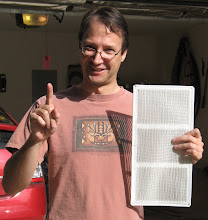- My attic lies between my entire living space and the sun
- My attic used to work against me, trapping the sun's energy
- My attic now works for me to reject the sun's energy
- Conduction: I had roughly R-20 insulation in the attic, enough to slow conduction somewhat, though far below code. This was probably my "least bad" heat transfer problem.
- Radiation: I had a composite shingle roof which gathered the radiant energy of sunlight all day, heating up and then radiating its own energy down into the attic all day and all night, where it heated up the air and the insulation. The energy that hit the insulation turned into heat in the insulation that eventually conducted into the living space, costing me energy to remove via air conditioning. This was probably tied with #3 as my worst heat transfer problem.
- Convection: I had very little air intake into the attic since my soffit vents were mostly blocked, and too few outflow vents on the roof, and those that I had were badly placed (not at the peak). Thus, all the air heated up by the radiant energy in #2 tended to stay in the attic for very long periods of time. In short, my attic was working as a rather effective solar oven to heat up a bunch of air, then hold it right next to my living space for a very long time. Again, this was probably tied with #2 as my worst heat transfer problem.
Contrast that to now, when through some rather simple improvements, I've seen the following:
- Conduction: In this most recent year, I've improved my insulation to about an R-49 level, current to today's building codes, from an R-20 level. This should be helping me reduce conduction gains in the summer (and losses in the winter) by some 50%. Again, my feel is that this is the least significant improvement for summertime (winter is another matter), which is one reason I did it last, but it should be helpful. Another reason to do this one last is that all the insulation gets in your way when you're trying to work in the attic!
- Radiation: In the last two years, I completed installing the radiant barrier. Instead of acting to gather the sun's heat and put it into my attic air and insulation, my attic now acts to reject over 90% of the sun's heat right back out through the roof, before it can warm anything other than the shingles.
- Convection: By opening more soffit vent intakes and installing a continuous vent along the ridgeline of the roof, I'm allowing convection to work for me to actively cool the attic by replacing air that heats up and rises through the ridge vent with cooler air that is at the outside air temperature. Since my attic routinely got over 150 degrees, and even on hot days, the outside air is around 100 degrees at the hottest, this has been a huge help.
All this talk of heat and 100 degree days seems odd right now in December. The temperature outside is in the 40's, and I do wonder what effect the improvements will have on my house's wintertime performance. Too much attic ventilation, after all, will keep that attic colder and will increase my conductive heat flow from the living space to the attic. The radiant barrier, while reflecting any radiated heat from the top of the insulation back down, is also rejecting the sun's rays that would be nice to have during this cold time of year. Both of these factors should be mitigated by the additional insulation I've added. After all, these improvements are a balancing act, hopefully well-tuned to the requirements of my local climate. Rest assured, efficiency enthusiasts, that this too will be analyzed in a few months as data comes in!


No comments:
Post a Comment